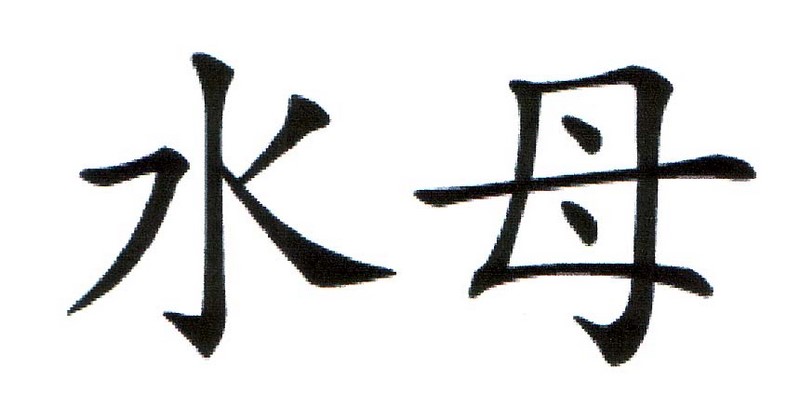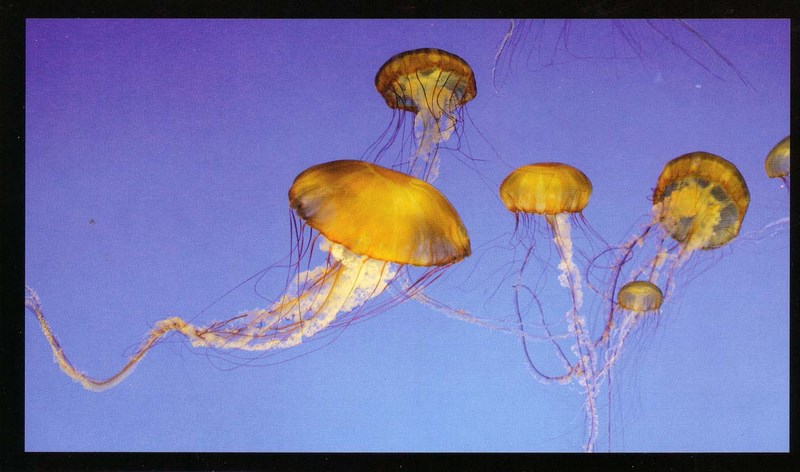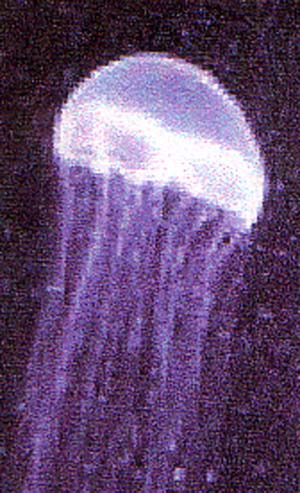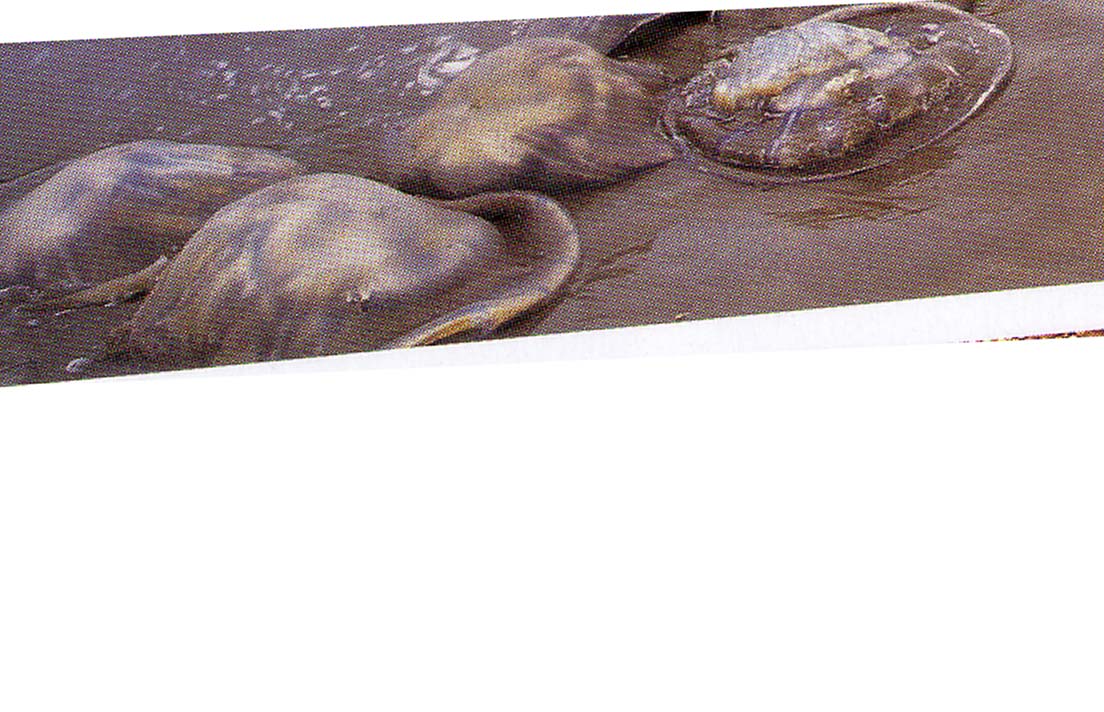
| What is Flavor and Fortune? |
| How do I subscribe? |
| How do I get past issues? |
| How do I advertise? |
| How do I contact the editor? |
Read 12726053 times
Connect me to:
| Home |
| Articles |
| Book reviews |
| Letters to the Editor |
| Newmans News and Notes |
| Recipes |
| Restaurant reviews |
| Article Index (all years, slow) |
| List of Article Years |
| Article Index (2025) |
| Article Index (last 2 years) |
| Things others say |
| Related Links |
| Log In... |
| Authors |
| Categories & Topics |
Jellyfish: A Royal Texture Food
| by Jacqueline M. Newman |
Unusual Ingredients
Summer Volume: 2006 Issue: 13(2) page(s): 7, 8, and 21
 Foods of the sea are popular world-wide for kings and commoners. The ones Americans adore by the ton are tuna, salmon, and pollock, followed by catfish and cod. Not so in China. These five rarely make it to the dinner or banquet table or to any feast. This is true now, and it was true in the past.
Foods of the sea are popular world-wide for kings and commoners. The ones Americans adore by the ton are tuna, salmon, and pollock, followed by catfish and cod. Not so in China. These five rarely make it to the dinner or banquet table or to any feast. This is true now, and it was true in the past.
The Chinese do covet one food of the sea, and always have. Royals and ordinary folk adore it at their banquets, feasts, and fine dining tables. Lacking fins and scales and really not even a fish, these invertebrates are members of the Scyphozoa or Cubozoano classes of simple animals. They have been around for millions and millions of years.
The Chinese know these are great foods and they call them hai zhe. Besides jellyfish, in translated into Chinese and in English they are known as monk’s hat, stone mirror, sea moon, and more. Prime Minister I Yin, an early Han Dynasty imperial cook, codified much of Chinese cookery and he mentions the jellyfish. He probably ate them as they abound along most of China’s coastline. Peng Zu and I Ya, both of whom preceded I Yin by several centuries were also consumers; but how they prepared them is not known.
The first actual Chinese jellyfish recipes come from the time of the Western Jin Dynasty which it lasted from 265 to 316 CE. Chinese food historians do not say much about them but do advise that jellyfish were first preserved with wood ash and salt water. They date that in the Song Dynasty (960 - 1279 CE) but list jellyfish as an Imperial food long before that. They note they have been eaten at royal houses from Zhou Dynasty times (1045 - 256 BCE) until the end of China’s dynastic times in the Qing dynasty (1911 CE).
 Jellyfish is one of many adored texture foods, the botanical name of those most often eaten is Rhopilema esculenta. Not all of them are edible and some are extremely poisonous, particularly should they sting you. They are all gelatinous masses of umbrella tops, most but not all with tentacles. Many do sting, though some only surround their prey. Some swimmers see them and run out of the water knowing that the pain they cause lingers for some time. Others are not bothered by these drifting eye-less animals with no real mouths that find and eat lots of algae. Some even run from those beached, but run they need not. However, not knowing the variety, they probably should not touch them.
Jellyfish is one of many adored texture foods, the botanical name of those most often eaten is Rhopilema esculenta. Not all of them are edible and some are extremely poisonous, particularly should they sting you. They are all gelatinous masses of umbrella tops, most but not all with tentacles. Many do sting, though some only surround their prey. Some swimmers see them and run out of the water knowing that the pain they cause lingers for some time. Others are not bothered by these drifting eye-less animals with no real mouths that find and eat lots of algae. Some even run from those beached, but run they need not. However, not knowing the variety, they probably should not touch them.
 The umbrella-shaped top of most jellyfish can sit on top of the water, and it is correctly called its mantle. The hanging things below the surface are are its tentacles. Some call the mantle or at least the center part of it, the head of the jellyfish, others call it the canopy. Some heads when soaked, look like corals. Hence, that is yet another name for some of these ancient creatures.
The umbrella-shaped top of most jellyfish can sit on top of the water, and it is correctly called its mantle. The hanging things below the surface are are its tentacles. Some call the mantle or at least the center part of it, the head of the jellyfish, others call it the canopy. Some heads when soaked, look like corals. Hence, that is yet another name for some of these ancient creatures.
As indicated, not all jellyfish are edible. Some cause death after a person gets stung, sometimes within minutes, a few do likewise when ingested. Many wonder why the Chinese like them and other crispy crunchy textured foods. Truth is, they deem and like anything aquatic, and these creatures are among those esteemed. They have been since the first Chinese folk actually prepared and consumed them. Yes, these unusual sea foods make their way to the head of things delicious along with other foods. They are often on the first cold plate at banquets or fancy family dinners.
Jellyfish are especially popular in and near the Fujian province. An ancient scholar-author, Thu Pentsun, wrote about them in his Guide to the Delicacies of the Sea. In Chinese, this book is called Hai Wei So Yun, and in it he calls these creatures cha. In Fujian today, they call them tha. Jia Sixie also wrote about them, his tome is translated as Essentials for Common People. These early volumes and later Chinese cookery volumes mention them but rare is the one that provides recipes.
 Do you know that though while fancy meals serve them, most Chinese do not know how to handle the jellyfish because they encounter and enjoy theirs only in restaurants. Common there and on the lips of many Chinese, few were used to prepare them; but this is changing. They can now be found in almost every Chinese market dried or semi-dried, salted and sealed in plastic bags. This recent availability with some blanched and sliced should mean more jellyfish will be used in homes.
Do you know that though while fancy meals serve them, most Chinese do not know how to handle the jellyfish because they encounter and enjoy theirs only in restaurants. Common there and on the lips of many Chinese, few were used to prepare them; but this is changing. They can now be found in almost every Chinese market dried or semi-dried, salted and sealed in plastic bags. This recent availability with some blanched and sliced should mean more jellyfish will be used in homes.
When we prepare ours, we do not like the pre-sliced ones because they are too thick and their quality too ordinary. We almost always have one or two in the refrigerator as they stay well for weeks, and we always purchase ours whole and uncooked. We rinse and re-rinse them before use, sometimes soak them overnight in the refrigerator before bringing a huge pot of water almost to the boiling point. With a long handled Chinese strainer in one hand, we drop one into the pot and take it out in about fifteen seconds thereafter; then we do the next one. They get rinsed under cold water for half minute, then immersed in ice water.
When in that very hot water, jellyfish shrink to one-tenth or less of their original size. We are sure to get them out of the water quickly or they get tough and chewy. High quality packaged jellyfish are the central part of the canopy. The apron or edge, sometimes called jelly-fish cheeks, can be sold separately and at a lower price. Cook them the same way, but for about fifteen or twenty seconds longer; likewise, the tentacles. Both apron and tentacles, after cooling, need to be sliced as thinly as possible. For the central or mantle part, cut the umbrella in half, and roll each as tightly as possible. Then with a very sharp very thin-bladed knife, slice them into slivers, The resulting long thin strips are ready to be marinated, then served.
Use a very good Chinese rice wine, a high quality Chinese thin soy sauce, and some fine white or black Chinese vinegar (or a mixture of both), and a little sugar for the marinade. Toss these with the jellyfish, then cover and refrigerate for an hour or two before serving; it is then they are ready to eat. Thin slivers of cucumber, blanched and separately marinated, or large white radish (daikon), both, or other items are mixed with the jellyfish just before serving. They provide different textures and reduce the cost per serving.
Provided below are several variations of items prepared with jellyfish. As already indicated, they can be and often are served alone. Years ago, jellyfish were cooked for longer periods of time, and there is such a recipe provided. Jellyfish are easy and quick to prepare and not expensive. We suggest you try making some; bet your family and guests will be impressed!
| Jellyfish and Roast Duck |
|---|
1 dried jellyfish, rinsed three times, then blanched in almost boiling water for fifteen seconds and removed and immediately put into cold or ice water 4 Tablespoons white Chinese rice vinegar 1 teaspoon sugar 1 teaspoon powdered chicken bouillon 1 Tablespoon thin soy sauce 1 Tablespoon sesame oil 1/2 pound roast duck breast, skin removed, and hand shredded 1 small piece red pepper, shredded 1 Tablespoon sesame seeds 1 sprig Chinese parsley, torn into its leafy segments Preparation: 1. Cut jellyfish in half, and roll each piece tightly. Using sharp knife, cut each half into the thinnest strips possible. 2. Mix jellyfish with rice vinegar, and allow to marinate for half hour, then drain. 3. Mix sugar, chicken bouillon, and soy sauce and toss with the jellyfish. Let rest fifteen minutes, then drain, and pile jellyfish high on a small platter. Top this with the shredded duck and then the red pepper shreds. 4. Sprinkle sesame seeds over it all and place Chinese parsley pieces around the outside of the platter. Toss before serving. |
| Jellyfish with White Radish |
|---|
1 dried jellyfish, rinsed three times, then blanched in almost boiling water for fifteen seconds and removed and immediately put into cold or ice water. 2 cups peeled and shredded white radish (also known as daikon) 1 teaspoon coarse salt 1 Tablespoon thin soy sauce 1 Tablespoon white Chinese rice vinegar 1 Tablespoon Chinese red vinegar 2 teaspoons sugar 1 teaspoon sesame oil sprig of Chinese parsley Preparation 1. Cut a jellyfish in half, then roll and slice as thinly as possible. Set aside covered and in cold water in the refrigerator for an hour, then drain. 2. Mix salt with the shredded radish and set aside for an hour, then drain, and put in a serving bowl. Mix with drained jellyfish. 3. Mix soy sauce, vinegars, sugar, and sesame oil, pour over jellyfish-radish mixture, and serve topping the jellyfish-radish mixture with the sprig of Chinese parsley. Toss after putting the bowl on the table. |
| Rice Noodles with Chicken and Jellyfish |
|---|
1 whole skinless and boneless chicken breast 2 dried jellyfish, rinse well 2 fresh rice noodle sheets 1 carrot 2 stalks celery 1/2 teaspoon salt 1 teaspoon sesame oil 2 Tablespoons thin soy sauce 1 Tablespoon lightly toasted sesame seeds Preparation: 1. Simmer chicken breast for eighteen minutes, cool enough to handle, then hand shred into very thin pieces, about two inches long. 2. After immersing jellyfish in hot water, cool immediately in ice water, and roll and cut into the thinnest of slivers, as in previous instructions. 3. Shred rice noodles and cut into four-inch lengths. 4. Cut carrot into two-inch long slivers, then blanched for thirty seconds and cut into an ice water bath. 5. String celery, cut into two inch slivers, and blanched for fifteen seconds then put into an ice water bath. 6. Drain carrots and celery, mix with chicken breast and jellyfish pieces, and then toss with one quarter of the rice noodles. Mix these with salt, sesame oil, this soy sauce and sesame seeds, and toss well. 7. Spread the remaining rice noodles on a serving platter and top with the chicken, jellyfish, and vegetable mixture, and serve. |
| Jellyfish and Crabmeat, Very Old Style |
|---|
5 or 6 large dried jellyfish, rinsed three times, then soaked for one hour 1 Tablespoon vegetable oil 1 shallot, cut in quarters 2 slices fresh ginger, cut into strips 4 cups chicken stock 1 Tablespoon Chinese rice wine 2 Tablespoons lard 1/4 cup Yunnan or Smithfield ham, cut in slivers 1/2 pound crab meat 1 Tablespoon cornstarch mixed with equal amount of cold water 1/8 teaspoon ground Sichuan pepper 8 trimmed stalks young bokcai or the hearts of another Chinese green, steamed for five minutes Preparation: 1. Bring eight cups of water to just below the boil, drop jellyfish in and immediately take out and put in bowl of ice water. Roll, then cut into thin strips. 2. Heat oil in a large pot and fry shallot and ginger just until it is fragrant, about one minute. Remove half and set aside, then put stock and wine into the pot and simmer for half hour. Add jellyfish and simmer for fifteen minutes, then remove it and set aside. 3. In wok or another pan, heat lard and add the reserved shallot and ginger pieces and the ham. Stir-fry for a minute. 4. Put vegetable into the stockpot and let it get hot. 5. Add crab meat to the ham mixture and stir, then add jellyfish strips, and stir once or twice before adding starch mixture and Sichuan pepper. Stir, put into stock pot, and serve. |
| Jellyfish and Cucumbers |
|---|
1 dried jellyfish, rinsed three times, then blanched for ten to fifteen seconds in almost boiling water, and immediately immersed in cold water 2 pickling cucumbers, sliced then cut into thin one-inch strips 4 Tablespoons white vinegar 1 Tablespoon Chinese black vinegar 1 Tablespoon sugar 1 Tablespoon sesame oil 1 Tablespoon thin soy sauce Preparation: 1. Roll blanched jellyfish, then cut it as thinly as possible. Soak in cold water in the refrigerator for an hour, then drain and put in a serving bowl. 2. Mix cucumber strips with jellyfish. 3. Mix vinegars, sugar, sesame oil, and soy sauce, and just before serving, pour over the jellyfish-cucumber mix. |

Copyright © 1994-2025 by ISACC, all rights reserved
Address
3 Jefferson Ferry Drive
S. Setauket NY 11720